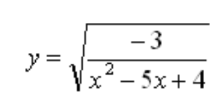AlexSendler100%
New member
- Joined
- Apr 1, 2021
- Messages
- 15
How can I find the domain of this function?
[imath]\qquad y = \sqrt{\dfrac{-3}{x^2-5x+4}\;}[/imath]
I mean, what in the square should be greater or equal to zero, but I can't divide the square because a square of -3 is impossible, and if I should make the inequality of all the expression to be great or equal to zero, how to solve this inequality
[imath]\qquad y = \sqrt{\dfrac{-3}{x^2-5x+4}\;}[/imath]
I mean, what in the square should be greater or equal to zero, but I can't divide the square because a square of -3 is impossible, and if I should make the inequality of all the expression to be great or equal to zero, how to solve this inequality
Attachments
Last edited by a moderator:

